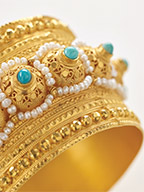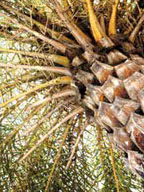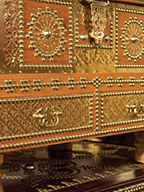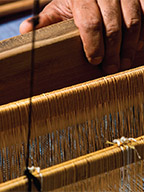Contact Center
.
Crafts
|
Goldsmithing | |
|---|---|
 |
Goldsmiths and jewelers use gold and silver in the manufacture of many jewelry and ornaments relying on his skill, artistic taste and vast experience. Usually, the goldsmith would smelt old jewelry to recreate new pieces or uses bullion imported from abroad from places such as India and Europe. |
|
Al Kurar | |
|---|---|
 |
Kurar embroidery produces beautiful handmade ribbons of gold zari, silver zari and briesam to decorate clothing. The technique, which is kept alive by an initiative led by the Shaikh Ebrahim bin Mohammed Al Khalifa Center for Culture and Research, is a group effort in which the width of the final product depends on the number of women involved in the process. The Qataba sits opposite her partners, who assumes the role of the Doakhil, holding and weaving several strands at a time while the Qataba guides the process and attaches the ribbon as it forms directly onto garments. |
|
Al Naqda | |
|---|---|
 |
Naqda is Arabic for the measuring unit of silver weight. Featured mostly in thoubs worn by women, bukhnaqs, and scarves, Al-Naqda embroidery is practiced by women to embellish modern products such as accessories, tissue boxes, gift boxes, and so on through an initiative led by the Awal Women’s Society. Using a special needle, the gold or silver thread is pulled through the cloth to create various motifs such as geometric shapes, flowers, crescent moons, stars, and so on. Tulle, wale cotton, or silk are preferred for this type of embroidery. |
|
Palm Tree Paper | |
|---|---|
 |
Bahrain’s identity has always been closely tied to palm trees. As a source of food and shelter, the palm tree proved to be an indispensable part of the lives of Bahrainis. In an initiative to reinterpret the use of palm leaves, the Children & Mothers Welfare Society presents the palm paper workshop to make handmade papers, cards, notebooks and illustrations. |
|
Traditional Chests Making | |
|---|---|
 |
More than just decorative elements in many houses, traditional chests known as Sanadeeg Mubayata are still used as storage for clothing and personal items. Its appearance is distinguished by its hammered-in nails to form various decorative patterns. These chests are made out of real wood and are often used to present the bride with her trousseau. Today, several traditional chest designs have been reinterpreted and now incorporate a variety of colors. |
|
Arabic Calligraphy | |
|---|---|
 |
As Arabic is the language of Islam and the Holy Quran, Arabic calligraphy spread collectively with the growth and spread of the Islamic Empire. In a short span of time, the artisans gave it a decorative beauty that no other calligraphy in the world has achieved. |
|
Naseej Weaving | |
|---|---|
 |
Working on looms in Bani Jamra and Al Jasra, Bahrain’s fabric weavers inherit the trade from father to son, producing lengths of cloth to turn to irdeh, a black abbaya with lines of red and gold worn by women, or the well-known wezar worn around the waist by men. Today, the craftsmen produce a multitude of items. In addition to traditional wear, scarves in varying colors are available for customization. While weaving, the craftsman uses both his hands and legs and distributing and overlapping the threads into each other in a systematic and coordinated manner. |
|
Boat Making | |
|---|---|
 |
As an island, boat making is a historic and iconic Bahraini industry. Over the centuries, Bahraini craftsmen developed a wide range of boats, each differing according to its purpose, from fishing, diving, pearling and transportation of goods and people. Made from imported lumber, the vessel’s exquisite balance in the high seas is testimony to the skill of Bahraini craftsmen who built them without the use of blueprints. |
|
Gypsum Engraving | |
|---|---|
 |
Bahrain’s old houses were decorated with engraved gypsum, especially atop windows, doorways, and the house’s guest rooms. This abstract art, characterized by symmetrical motifs, denoted the prestige and social status of the owner of that household. |
|
Saff (Palm Tree Leaves Products) | |
|---|---|
 |
The craftsman utilizes palm leaves to make several items available in Bahraini homes including the sofra dining mats, baskets, hand fans and bird traps. It is one of the island’s most prominent crafts and is still practiced in several areas. |
|
Rush Mat Weaving | |
|---|---|
 |
The villages on Sitra Island and the neighboring agricultural areas were the center of the rush mat weaving industry as the raw material needed in those locations, the so-called “asal” plant, was found in abundance nearby. This plant, which grew in coastal salt marches (sabkhas) and near sewage waters, would be cut by the weaver and left to dry on extended ropes until it was ready for weaving into rush mats used to line the floors of houses, mosques, coffee houses, and shops. |
|
Pottery Making | |
|---|---|
 |
Pottery is an industry Bahrain has been famous for since ancient times, as indicated by the vast quantity of millennia old examples found in archaeological sites across Bahrain thanks to the availability of locally-sourced raw materials. The wide range of pottery on display illustrates the advanced level attained by Bahraini craftsmen who learned their trade from their forefathers. |
|
Metal Works | |
|---|---|
 |
The craftsmen design, fabricate and mold the brass, copper, gold and iron to make objects that are used in traditional Bahraini households such as jewelry, Arabic coffee pots, swords and other objects traditionally used. |







